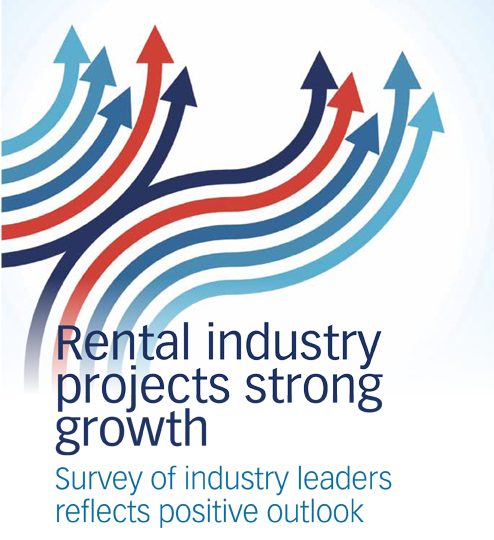Rental industry projects strong growth

By David Wolff
North American rental revenues are projected to be $41.1 billion in 2014 and reach $52.3 billion by 2017, led by strong growth in the U.S. equipment rental market coupled with steady growth in Canada.
According to the latest information from the American Rental Association (ARA) Rental Market Monitor, the North American industry posted another impressive year of growth in 2013. Overall, North American rental revenue came in at $38 billion, with U.S. revenues accounting for $33.3 billion and Canada accounting for the additional $4.7 billion.
Construction and industrial equipment rentals continued to produce the largest share of 2013 rental revenues of any U.S. segment with $22.3 billion, followed by the general tool segment at $8.5 billion, and the party and event segment with $2.5 billion. Overall, 2013 rental revenues grew at a year-over-year rate of 6.4 percent, with the construction and industrial equipment segment leading the way with year-over-year growth of 7.3 percent, followed by general tool with 5.3 percent growth and party and event with 2.8 percent growth.
Scott Hazelton, senior partner of IHS, the economic forecasting firm that compiles the data says, “These numbers suggest that the economic recovery in the construction and industrial equipment market continues at a strong pace. The stronger growth in this segment is also evidence of the secular shift we have seen in recent years that results in more rental and fewer equipment purchases by contractors and industrial customers.”
Another bright spot in the forecast comes from the investment numbers. Total investment in rental equipment in 2013 was $11.1 billion. Again, the construction and industrial sector led the way with $7.5 billion in investment, followed by the general tool segment with $3.2 billion and party and event with $400 million. Year-over-year investment growth was 10.3 percent, slower than the previous two years due to market stabilization and the rapid re-fleeting that occurs following a financial crisis.
The IHS forecast shows U.S. revenues predicted to grow at rates well above seven percent throughout the forecast period that extends through 2017. Growth is expected to be especially strong in the construction and industrial equipment and general tool segments, which will see year-over-year growth peak at 11.1 and 15.2 percent respectively.
Hazelton says, “Overall, 2013 was another good year for the equipment rental industry as it continues to far outpace the general economy. We continue to see the equipment rental industry as a leader in the economic recovery over the next five years.”
Survey industry leaders
At the recent Rental Show in Orlando, Fla., Pro Contractor Rentals spoke with a number of industry leaders about the state of the rental market. We asked them: "What is the outlook for the rental industry this year and beyond?"
 Justin Blount
Justin Blount
Vice President of Marketing
Kohler Power Systems
Kohler Wis.
“We are really excited about the rental industry,” Blount says. “It is one of the few growth areas where we are adding more resources. Based on some of the emissions requirements needed now and in the future, there is an opportunity for us to invest in more innovation. We see rental as a growth opportunity from an engine perspective, as well as for generators on the power side. Whether it is tow-ables or our new line of portables, we think we have unique solutions for contractors to help them be more efficient and have a lower cost of ownership.”
At The Rental Show, Kohler Power Systems introduced its new line of mobile generators. The 45REOZT4 (45 kVA) diesel-powered genset is Tier 4 Final-compliant and ideally sized for rental companies. It features the Kohler KDI (Kohler Direct Injection) 2.4L diesel engine that does not require a diesel particulate filter, which means it produces EPA-compliant power in a smaller space. It can be mounted to a standard wheeled trailer with an electric braking system or fitted on a drag-able field skid when mobility is not a concern.
“This is cutting edge technology that we believe can continue to add more value to the rental industry,” Blount says. “We did an ethno- graphic study and found that contractors are very diverse people. Some like wheels, some don’t. Some like handles, while others don’t. We took that information and came out with a way to customize our portable models for the way customers want them. They can be built to fit their needs, and be more efficient and affordable. That’s an example of our listening and using innovation and design to solve a problem.”
He continues, “Our mission at Kohler is to provide a gracious living experience. Part of that is we want people who use our products to be able to say in five to 10 years that they enjoy the experience and have a smile on their face. We believe there are opportunities to bring innovation and unique industrial design to help people be more efficient and save money.”
 Neil Borenstein
Neil Borenstein
Director of Marketing
The Toro Company
Bloomington, Minn.
“The rental industry will be driven by construction,” Borenstein says. “We saw growth in home construction last year, and that will continue into this year and 2015. We will also see commercial construction starting up, and that will add to the demand for rental equipment. Furthermore, we’ve seen a shift with contractors from owning to renting. They want more specialized equipment that fits their needs. They may have been financially bound by the downturn. Renting gives them more flexibility to have access to equipment, but without committing their capital.
“We are very excited about the rental business coming out of the recession,” he continues. “We purchased Stone Equipment, which added new lines for us with compaction, concrete and masonry products. That’s how we’re trying to serve the construction and homebuilder market. Toro has a very big presence in turf, and we’ve introduced a new line of turf renovation products such as aerators, seeders and power rakes. Not only are people building new homes, they’re
improving their current homes.”
 Justin Kissinger
Justin Kissinger
Marketing Manager
Custom Equipment
Richfield, Wis.
“Rental is a growth market, and our primary target,” Kissinger says. “We need a broad product range for the rental industry, but we’re always looking for opportunities to provide unique products.
Different sizes, features, functionalities – the right product for the right job in all situations. Part of that process is finding a niche market, and the other is how Hy-Brid Lifts differentiates itself. Our goal is to design and build low-level access scissor lifts that provide better lifting capacity, a smaller footprint, better maneuverability, lighter weight and lower floor loading.
He continues, “Our newest product, the HB-1230, has all the benefits of a mast lift, but with a bigger platform. Most of the scissor lift industry has been focused on equipment that goes 19 feet and higher, but we offer a line for everything below. Many applications where people are using 19-foot lifts can be accomplished with lower-access lifts, which have several benefits, including fewer opportunities for operator injury. With more stringent job site safety requirements, safety directors and large contractors are asking for stronger safety features than even regulations call for, such as motion beacons, pressure level restrictions, lanyards and harnesses. We stress choosing the right lift for the job. If the ceiling is 16 feet tall, the customer doesn’t need a 19-foot lift. A 14-foot lift eliminates the possibility of an entrapment issue or a crushing hazard because the operator can’t physically hit the ceiling with the lift.”
Kissinger says, “Compared to the last few years, rental is definitely picking up. We’ve been getting more inquiries and seeing more growth. Going forward, everything looks promising. The outlook for the rental industry appears a lot more positive than it used to be.”
 Scott Smith
Scott Smith
Director of Sales
Ditch Witch
Perry, Okla.
Smith, who is an associate member of the ARA board of directors, says, “Standing here at The Rental Show last year, we knew 2013 would be a good year for our rental customers in certain geographic areas around the country. For example, markets with oil and gas business would see very good growth. Twelve months later, 2014 and 2015 extremely positive for a wider portion of the country. We’ve got a rental industry outpacing U.S. economic growth by a factor of three or four to one. We are excited because we believe that will be constant growth over the next couple of years.”
He continues, “From a product standpoint, we are continuing to key on our products serving the independent rental customer. One of our biggest challenges is Tier 4 engine changes. We’re doing our best to manage those changes to try to lessen the inevitable impact on the rental store owner, as well
as the customer.”
 Courtney DeMilio
Courtney DeMilio
Associate Vice President
Lojack Corp.
Canton, Mass.
“The rental industry really started to thrive out of the down economy in late 2010,” DeMilio says. “The uptick has been very steady and is still actively climbing as we start 2014.
In my opinion, part of the outcome of the fallen economy is a change in the way construction businesses operate. In the past, contractors were investing heavily in buying a fleet. Now, and seemingly for the years to come, renting equipment makes much better business sense. For LoJack, this evolves to the reality of theft. The theft trends tend to follow the ups and downs of the rental industry. The more exposed the rental equipment is out on the job sites, the more vulnerable it is to be stolen. In turn, the more equipment out on rent, the more demand there is to do construction jobs. This brings opportunity to the thief. Additionally, we see the growing impact of product evolutions such as Tier 4 engine requirements. I predict the increase in cost, machine demand and flutter of national disasters will have a short- and long-term impact to the construction power rental industry. Tier 4 is in effect, and it will contribute to a very positive environmental goal, but will also subject that equipment class to more theft.
“We are excited to see the economy booming in construction rental,” she continues. “LoJack proudly supports this segment of the construction industry and takes great pride in recovering assets quickly so that the renter and owner have healthy businesses.”
 Greg Petherbridge
Greg Petherbridge
Product Manager
Chicago Pneumatic
Independence, Ohio
Petherbridge expects contractors to make fewer capital expenditures on tools and equipment and to rent more.
“If a guy is doing a $100,000 job, he won’t buy a $50,000 hammer,” he explains. “Instead, he will spend $4,000 to rent the tool for this job and the next because he doesn’t know where his next jobs are coming from. Contractors are fearful of buying new equipment. They rent for the next job because they can’t plan far enough ahead with the mixed numbers we’re getting in the economy.”
To meet this demand, Chicago Pneumatic is building its inventory.
“We want to have more items in stock for the big-spurt orders,” Petherbridge says. “If we normally have 50 units on hand, we may increase that to 65. We’re keeping a safety stock because of the trend toward rental. We could get an order for 30 or 40 units tomorrow because a big project was approved, when that’s all we anticipated we’d need for a month. For example, there is a big push in the natural gas oilfields, and that’s been huge for us. Compressors and breakers are in large demand; there has to be a pad for every drill site. If the project is in Pennsylvania, Ohio or New York there’s rock underground. Contractors can’t just start digging.”
He continues, “We see more and more rental companies increasing the size of their fleets. There will be a lot of growth in the rental industry in the next few years.”
 Dean Barley
Dean Barley
Vice President and General Manager
Terex Construction Americas & Global Aftermarket
Westport, Conn.
“The North American rental market is strong going into 2014, while the market outlook for beyond for Terex is excellent given the recent developments in our product offerings and the continued product improvements we’ve made,” Barley says.
“The introduction of Tier 4 products should generate additional channels to market used equipment outside of North America and support used equipment pricing, while the demand for new equipment should increase. I feel that Terex has now positioned itself as a supplier of choice for customers. We have invested smartly in the support and services available after the sale to take care of customer needs.”
Originally published in the March/April 2014 issue of Pro Contractor Rentals. Copyright 2014 Direct Business Media.








